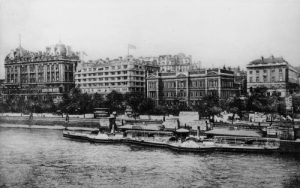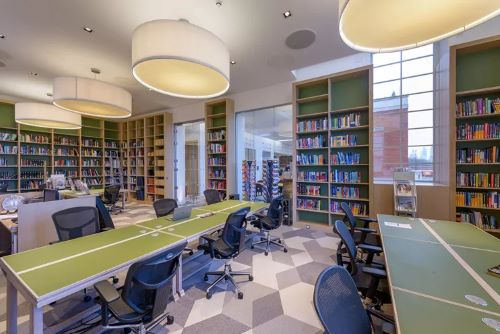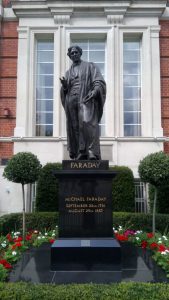Library of the Week: 12th June: We have a brilliant post this week written by Daniel Simkin – Deputy Librarian at The Institution of Engineering and Technology Library and Archives! Find out more about the history of the IET as well as the amazing collections held at their Library and Archives. Thank you for taking part!
The Institution of Engineering and Technology (IET) was formed in 2006 when The Institution of Electrical Engineers (IEE) and The Institution of Incorporated Engineers (IIE) merged. However, the history of the IET is made up of over forty predecessor institutions dating to 1854 when The Society of Engineers (SoE) was founded.
In 1871 reflecting developments in telegraphy The Society of Telegraph Engineers (STE) was formed. The first president of the STE was Sir Charles William Siemens who came to England in 1843 and founded the British branch of the Siemens engineering company which was associated with major developments in telecommunications during the end of the nineteenth century. In 1889, reflecting advances in electrical technology and the growth of electrical engineering as a profession, the IEE was formed.

The IET Library and Archives are in two adjacent buildings, Savoy Place and Savoy Hill House in London on the North bank of the Thames. Savoy Place was originally built as a joint examination hall for the Royal College of Physicians and the Royal College of Surgeons. In 1909 the IEE purchased the lease from the Duchy of Lancaster. Today it houses the library reading room, offices and storage facilities. Savoy Hill House was built in 1880 and is home to the IET Archives with a reading room and archive strong room.

The library is part of a larger member’s area that can be used to hold meetings, study or just relax. We collect and maintain books across a wide range of engineering topics including those published by the IET. As well as areas you might traditionally think of as being of interest to electrical engineers such as power generation, satellite communications and transport, our members are involved in emerging industries such as artificial intelligence, self-driving vehicles and smart technologies and so our digital and print collections must be managed to meet the fast pace of change in electrical engineering.
As well as thousands of books, journals, pamphlets and reports, we have growing digital collections that includes e-books, e-journals, and standards, the majority of which our members can access 24/7 from home which is vital as although our library is in London our membership is spread across the world. We also offer several services to help our members use our collections efficiently. These include a research service where we help to find sources on a specific subject and locate facts and statistics. We also produce monthly reading lists on a range of engineering topics that highlight a curated selection of e-books and e-journals. Some recent reading lists have covered coding and programming, power systems engineering and smart technologies. We are also working on new ways to engage with our members and recently ran a webinar for prospective library users and are looking to do similar events in the future.

The IET Archives collect and retain material relating to the IET and its predecessor institutions as well as the history of engineering and technology. As well as records from the IET’s 150-year history, the archives also hold several other significant collections. These include the papers of Sir Francis Ronalds, and Oliver Heaviside, and the Faraday Collection which consists of notebooks, correspondence and manuscripts covering Michael Faraday’s travels in Europe with Sir Humphry Davy, his notes and letters from many notable people of the time. Three other collections are the archives of the Women’s Engineering Society, the Electrical Association for Women and the personal papers of Dame Caroline Haslett. The Library and Archives Twitter account regularly showcases items from the archives and rare book collections. There is also an archives blog which examines and describes items from the collections in more detail.
We hold two rare book collections, the library of Sir Francis Ronalds and Silvanus P. Thompson’s library. The former was given to the IET in 1876 and comprises about 2000 volumes and 4000 pamphlets on electricity and magnetism. The Library of Silvanus P. Thompson was purchased by the IET in 1917 and is made up of 900 rare books, 3700 scientific and technical books and 8000 pamphlets. The library includes rare books from the fifteenth to the seventeenth centuries and thirteen manuscripts including Peter Peregrinus’ Epistola De Magnete and Chaucer’s Astrolabe, dated 1391.
I’ve worked at the IET for almost four years firstly as Research Librarian and now Deputy Librarian. I work with members to answer their research questions and help them with using our collections, as well as assisting the Library Manager with acquisitions and service planning. In addition to this I look after the rare book collections and my favourite item is from these.

The Botanic Garden is a collection of two poems, The Economy of Vegetation and The Loves of Plants, written by Erasmus Darwin and first published in 1791. The edition held by the IET Library and Archives is the fourth edition from 1799 and forms part of the collection of Silvanus P. Thompson purchased in 1917 by the IET. The book is notable for reproducing five engravings by the English artist and poet William Blake, including that of the Amaryllis.
It is one of the first popular science books, with Darwin using verse to encourage interest in botany and science generally amongst readers. There was some disagreement as to Darwin’s skill as a poet with William Wordsworth describing it as “dazzling” whilst Samuel Taylor Coleridge claimed, “I absolutely nauseate Darwin’s poem”.
The library is open 10am-4pm Monday to Friday and non-members of the IET can use the facilities for reference purposes. For any enquiries you can email us at libdesk@theiet.org. To book an appointment to view items in the archives please email archives@theiet.org.
Daniel Simkin – Deputy Librarian
All images copyright of IET Library and Archives, reproduced with kind permission of the copyright holder.
You can explore the library’s collections on Discover and find further contact details on their Discover information page.

